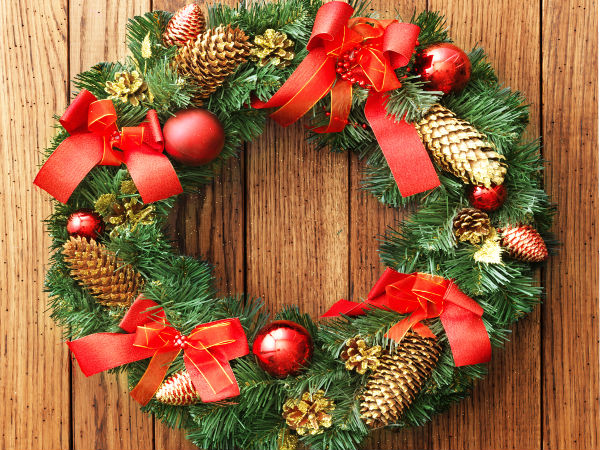The Festive Circle: A History And Significance Of The Christmas Wreath
The Festive Circle: A History and Significance of the Christmas Wreath
Related Articles: The Festive Circle: A History and Significance of the Christmas Wreath
Introduction
In this auspicious occasion, we are delighted to delve into the intriguing topic related to The Festive Circle: A History and Significance of the Christmas Wreath. Let’s weave interesting information and offer fresh perspectives to the readers.
Table of Content
The Festive Circle: A History and Significance of the Christmas Wreath

The Christmas wreath, a circular arrangement of evergreen boughs, berries, and ornaments, is a ubiquitous symbol of the holiday season. Its presence on doorsteps, mantles, and tables across the globe signifies the arrival of Christmas, evoking feelings of warmth, celebration, and tradition. This article delves into the history, symbolism, and significance of the Christmas wreath, exploring its evolution and enduring appeal.
Origins and Ancient Symbolism:
The concept of a circular arrangement of greenery dates back to ancient times. In ancient Rome, wreaths of evergreen were worn during Saturnalia, a week-long festival dedicated to Saturn, the god of agriculture. These wreaths, adorned with fruits and candles, represented the cyclical nature of life and the return of spring.
Similarly, in ancient Egypt, wreaths of laurel were used to symbolize victory and honor. In Norse mythology, the evergreen Yule log, a precursor to the Christmas tree, was a symbol of eternal life and the promise of a fruitful harvest.
The Advent Wreath: A Christian Tradition:
The advent wreath, a specific type of Christmas wreath, holds significant religious meaning. It typically consists of four candles, representing the four Sundays of Advent, the period of anticipation leading up to Christmas. The candles, often purple or blue, symbolize hope, peace, joy, and love, each illuminating a different aspect of the coming of Christ.
The tradition of the advent wreath is believed to have originated in Germany in the 16th century. It was introduced into the United States by German immigrants in the 19th century and quickly gained popularity.
The Christmas Wreath: Symbolism and Significance:
The modern Christmas wreath, while drawing inspiration from ancient and religious traditions, has evolved into a symbol of the holiday season as a whole. Its circular shape represents the eternal cycle of life, with the evergreens symbolizing hope and resilience in the face of winter.
The vibrant colors of the ornaments and berries add to the festive atmosphere, while the scent of pine needles evokes a sense of warmth and comfort. The Christmas wreath serves as a welcoming beacon, inviting friends and family to share in the joy of the season.
Beyond the Symbolic: Practical Benefits:
Beyond its symbolic significance, the Christmas wreath also offers practical benefits. Its evergreen boughs, with their natural oils, possess insect-repelling properties, making them a natural deterrent against unwanted pests. The scent of pine needles can also help purify the air, creating a fresh and invigorating atmosphere.
Crafting a Christmas Wreath: A Tradition of Creativity:
The act of crafting a Christmas wreath can be a cherished tradition, bringing families and friends together in a shared creative experience. From choosing the perfect evergreen boughs to selecting the ornaments and embellishments, each step in the process allows for personal expression and creativity.
Choosing the Right Wreath:
With the vast array of Christmas wreaths available, choosing the right one for your home can be a delightful yet daunting task. Consider the following factors:
- Size: The size of the wreath should be proportionate to the door or space where it will be displayed.
- Materials: Traditional evergreen wreaths are made from fir, spruce, or pine branches. Other materials, such as grapevine, cedar, or even artificial branches, can also be used.
- Ornaments and Embellishments: The ornaments and embellishments should complement the overall style of your home decor. Consider colors, textures, and themes.
Tips for Displaying a Christmas Wreath:
- Placement: The Christmas wreath is traditionally hung on the front door, but it can also be displayed on interior doors, mantles, or even as a centerpiece on a table.
- Hanging Method: Use a wreath hanger specifically designed for the weight of the wreath. Alternatively, you can use a ribbon or twine to create a loop for hanging.
- Maintenance: To keep the wreath fresh and vibrant, mist it with water occasionally.
FAQs about Christmas Wreaths:
- Q: When should I put up my Christmas wreath?
A: The traditional time to put up a Christmas wreath is the first Sunday of Advent, which typically falls in late November or early December. However, many people choose to put up their wreaths earlier or later, depending on their personal preferences.
- Q: How long should I keep my Christmas wreath up?
A: It is generally considered appropriate to keep a Christmas wreath up until after the New Year, or even until the beginning of February. However, the exact time frame is ultimately a matter of personal preference.
- Q: How do I dispose of a Christmas wreath properly?
A: If your wreath is made from natural materials, you can compost it or simply discard it in your yard waste. Artificial wreaths can be recycled or donated to a local charity.
Conclusion:
The Christmas wreath, a timeless symbol of the holiday season, continues to hold a special place in homes and hearts around the world. Its historical roots, religious significance, and practical benefits make it a cherished tradition that evokes feelings of warmth, celebration, and anticipation. Whether crafted by hand or purchased ready-made, the Christmas wreath serves as a visual reminder of the joy and spirit of the season, welcoming friends and family into a festive atmosphere.








Closure
Thus, we hope this article has provided valuable insights into The Festive Circle: A History and Significance of the Christmas Wreath. We hope you find this article informative and beneficial. See you in our next article!
Leave a Reply